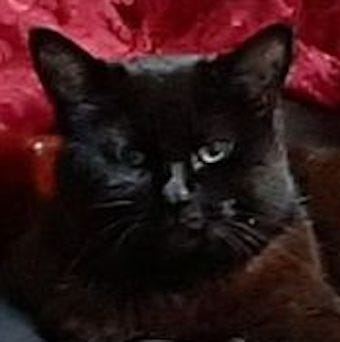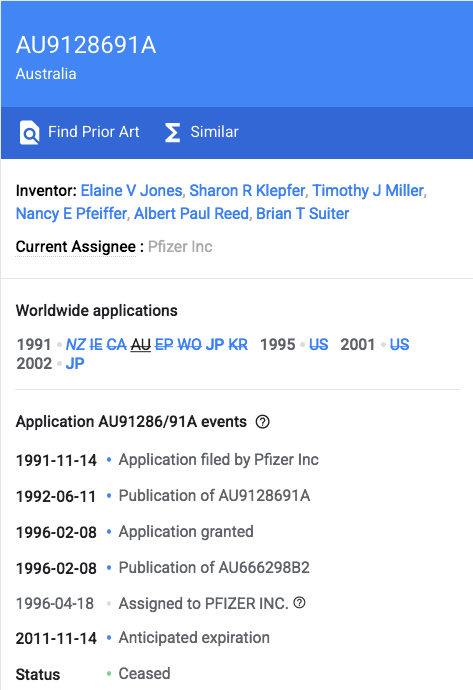Australian Patent on Recombinant Feline Coronavirus Spike Proteins 1991
Thanks to Dr David Martin for reminding us that Pfizer interest in Genetic Modification of Coronavirus goes back to the 1990s. Let's have a look at Weaponization of Pet Viruses as well.
Companion animals are valued members of many families, including my late parents’ cat Minnie, sadly no longer with us.
The Pet market is huge, with explosive consumer expenditure on veterinary bills and Pet Insurance.
See my article on TGA testing in 2017 of the Plasmid used in the withdrawn Boehringer Ingelheim Animal Health Australia Pty. Ltd. Merial ONCEPT jab.1
Jabbing Pets is very popular and new threats are required for Fear Marketing.
Below is the ceased 1991 Australian patent2 that caught my eye when I went hunting after David Martin mentioned Pfizer history of evil virus manipulation in his recent interview with Graham Hood and John Larter.3
Unfortunately I have not found a version with intact figures, so I went after some of the authors.
Tracing Nancy E Pfeiffer, I found she was working with SmithKline Beecham Animal Health, Lincoln, Nebrasks, USA and submitted a paper4 in 1989 on the Feline Virus Intranasal vaccine that took a year to be accepted, but did not appear online until 2002, presumably because patents and IP swaps were in play.
Abstract
Cats vaccinated intranasally (i.n.) with a temperature sensitive feline infectious peritonitis virus (ts-FIPV) vaccine were protected against an FIP-inducing challenge. Seventeen of 20 vaccinated cats (85%) survived a rigorous virulent FIPV challenge that caused FIP in 12 of 12 non-vaccinated cats (100%), 10 (83%) of which died. Intranasal vaccination stimulated serum IgG and serum and salivary IgA antibody responses (measured by ELISA), FIPV-neutralizing antibody (VN), and a cell-mediated immune (CMI) response as measured by lymphocyte proliferation. The serum antibody response to vaccination was not associated with protection. In fact, the IgG, IgA and VN titres were much higher in control cats than in vaccinated cats following challenge suggesting an immune-mediated pathogenesis.
In contrast, stimulation of a mucosal IgA response to vaccination was related to protection. The in vitro proliferation of peripheral blood lymphocytes in response to virulent FIPV was observed in vaccinated cats, in vaccinated and challenged cats but not in non-vaccinated challenged cats.
Earlier this group, working with Norden Laboratories, Lincoln, Nebraska, explained that Cats have a natural immunity to one strain of the Virus, that is killed off by minor fever of 39 degrees C, but another strain can replicate at lower temperature in the upper respiratory tract.5
The characteristics of a temperature sensitive feline infectious peritonitis virus (TS-FIPV) were examined. TS-FIPV, unlike its parent strain, DF2 wild type FIPV (WT-FIPV), propagated at 31 °C (permissive temperature) but not at 39 °C (nonpermissive temperature). This temperature preference of TS-FIPV was also demonstrated in cats by the ability of the virus to replicate only at the lower temperature in the upper respiratory tract and not at systemic sites where higher temperatures (38–39 °C) prevail. Viral structural proteins and RNA were synthesized at 39 °C but some undefined maturational defect prevented the formation of infectious TS-FIPV at its nonpermissive temperature. TS-FIPV was more thermolabile than WT-FIPV which indicated alterations in the structural proteins of TS-FIPV, and a difference in the envelope protein of the two viruses was revealed by Western blot analysis. Plaque assay characterization showed that TS-FIPV produced small plaques in comparison to the large plaques of WT-FIPV. These unique characteristics possessed by TS-FIPV may account for its nonvirulent nature and ability to stimulate protective immune responses in cats.
Vaccinated Cats died Faster
Tracing Sharon R Klepfer was very useful and I found a 1995 paper6 on Feline Vaccine Enhanced Disease. By this time S. Klepfer, A. P. Reed and E. Jones were with Smithkline Beecham Animal Health in King of Prussia, Pennsylvania and T. J. Miller was still in Lincoln, Nebraska. This time they were working with Zonagene, Inc. in The Woodlands, Texas.
Earlier in 1994 they published some of their Spike Gene cloning techniques.7
Others Killing Cats more efficiently
Found lovely work emanating from a Cambridge University group using GMO viruses to increase Lethality which centred on the PhD thesis of Brian C. Horsburgh.8 They were working with Intervet (UK) Ltd.
The abstract reads:
Feline infectious peritonitis (FIP) is a progressive, debilitating disease of wild and domestic Felidae caused by infection with the coronavirus feline infectious peritonitis virus (FIPV). Two forms of FIP are observed - the commoner wet or effusive form in which the abdomen is distended by the accumulation of a fibrin-rich exudate within the peritoneal cavity and the dry or non-effusive form in which there is a desseminated granulomatous disease involving most organs. Mortality approaches 100% for both forms.
Dogs effectively Killed as well
In 1995 the Cambridge group published more on their GMO viruses applied to Dogs.9
Abstract
The gene encoding the spike (S) protein from two geographically distinct strains (American and British) of canine coronavirus (CCV) was cloned and sequenced. The nucleotide sequence revealed open reading frames of 1443 or 1453 amino acids, respectively. Structural features include an N-terminal hydrophobic signal sequence, a hydrophilic cysteine-rich cluster near the C-terminus, two heptad repeats and 29 or 33 potential N-glycosylation sites. Pairwise comparisons of S amino acid sequences from these isolates with other CCV strains (Insavc1 and K378) revealed that heterogeneity, found mostly in the form of conservative substitutions, is distributed throughout the canine sequences. However, 5 variable regions could be identified. Similar analysis with feline, porcine, murine, chicken and human coronavirus sequences revealed that the canine sequences are much more closely related to the feline S protein sequence than to the porcine S protein sequences even though they are all from the same antigenic group. Moreover, the sequence similarity between CCV isolates and the feline coronavirus, feline infectious peritonitis virus (FIPV) was comparable. Expression of the CCV or the transmissible gastroenteritis virus (TGEV) S gene using the vaccinia virus system produced a protein of the expected size which could induce extensive syncytia formation in infected canine A72 cells.
More on the lethality of Syncytia.10
Pfizer patents reveal more on the Canine GMO Viruses.11 12
They used Canine Coronavirus from the American Type Culture Collection (ATCC) in Rockville Maryland, a central facility of US Bioweapons development as I mentioned earlier in the Centreville High School student Psyop.131415
In US Patent 6,602,504 B2 they describe using E. coli host strain XL1 Blue from Stratagene Cloning Systems, La Jolla, California and T4 DNA ligase from Boehringer Mannheim Biochemicals, Indianapolis Indiana.
In case you missed earlier articles on Pfizer GMO Viruses.16
Hope you find this assists with your own research into Bioweapons and “Countermeasures”.
TGA E. Coli PlasmidGate 2017
Please excuse me if other Substack authors have covered this before, and point me to their articles.
Elaine V Jones, Sharon R Klepfer, Timothy J Miller, Nancy E Pfeiffer, Albert Paul Reed, Brian T Suiter. Application filed by Pfizer 14 November 1991. https://patents.google.com/patent/AU9128691A/en
https://x.com/FluoridePoison/status/1882548441055912185
J.D. Gerber, J.D. Ingersoll, A.M. Gast, K.K. Christianson, N.L. Selzer, R.M. Landon, N.E. Pfeiffer, R.L. Sharpee, W.H. Beckenhauer. 1990. Protection against feline infectious peritonitis by intranasal inoculation of a temperature-sensitive FIPV vaccine. https://www.sciencedirect.com/science/article/pii/0264410X90900046
K K Christianson, J D Ingersoll, R M Landon, N E Pfeiffer, J D Gerber. 1989. Characterization of a temperature sensitive feline infectious peritonitis coronavirus. Arch Virol. 109(3):185–196. https://pmc.ncbi.nlm.nih.gov/articles/PMC7086852/
S. Klepfer, A. P. Reed, M. Martinez, B. Bhogal, E. Jones & T. J. Miller. Cloning and Expression of FECV Spike Gene in Vaccinia Virus. Immunization with FECV S Causes Early Death after FIPV Challenge. Advances in Experimental Medicine and Biology, Vol 380. Editors. Pierre J. Talbot and Gary A. Levy. Springer, Boston, MA. https://doi.org/10.1007/978-1-4615-1899-0_38
A. Paul Reed, Sharon Klepfer, Timothy Miller and Elaine Jones. CLONING AND SEQUENCE ANALYSIS OF THE SPIKE GENE FROM SEVERAL FELINE CORONAVIRUSES. In: Laude, H., Vautherot, JF. (eds) Coronaviruses. Advances in Experimental Medicine and Biology, Vol 342. Springer, Boston, MA. https://link.springer.com/chapter/10.1007/978-1-4615-2996-5_3
W. Stuart K. Chalmers, Brian C. Horsburgh, William Baxendale & T. David K. Brown. 1993. Enhancement of FIP in Cats Immunised with Vaccinia Virus Recombinants Expressing CCV and TGEV Spike Glycoproteins, in Coronaviruses Molecular Biology and Virus-Host Interactions. Editors Hubert Laude, Jean-François Vautherot. Advances in Experimental Medicine and Biology Volume 342. https://link.springer.com/chapter/10.1007/978-1-4615-2996-5_55
B C Horsburgh and T D Brown. 1995. Cloning, sequencing and expression of the S protein gene from two geographically distinct strains of canine coronavirus. Virus Res 39(1):63-74.
Pfizer appoints Chris Boshoff who proved that Endotoxin causes Cell Fusion
Very interesting appointment given Pfizer market strategy to exploit his knowledge of Bird diseases and Respiratory Syncytia.
Timothy J. Miller, Lincoln, Nebraska, Sharon Klepfer, Broomall; Albert Paul Reed Exton, both of PA. United States Patent 6,057,436. Filed 7 May 1993. Continuation-in-part of application No. 07/880,194, May 8, 1992, abandoned, which is a continuation-in-part of application No. 07/698,927, May 13, 1991, abandoned, which is a continuation-in-part of application No. 07/613,066, Nov. 14, 1990, abandoned.
Timothy J. Miller, Lincoln, NE; Sharon Klepfer, Broomall, PA; Albert Paul Reed, Exton, PA; Elaine V. Jones, Wynnewood, PA. United States Patent 6,602,504 B2. Filed 5 October 2001. Division of application No. 09/494,151, filed on Jan. 28, 2000, now Pat. No. 6,372,224, which is a continuation of application No. 08/331,625, filed on Nov. 23, 1994, now Pat. No. 6,057,436, which is a continuation-in-part of application No. 07/880,194, filed on May 8, 1992, now abandoned, which is a continuation-in-part of application No. 07/698,927, filed on May 13, 1991, now abandoned, which is a continuation-in-part of application No. 07/613,066, filed on Nov. 14, 1990, now abandoned.
Centreville Student Supervisors Make GMO Live Covid19 Virus tuned to Replicate in Humans
Further details of Covid19 made on US Soil in 2022 designed to be sprayed as well as jabbed.
Moncef Slaoui - Arsenic, Endotoxin and Radiation Poisoning Expert
Thanks to Hedley Rees, who prompted me to write another in my series on Endotoxin Experts. He abandoned Cancer Vaccines to pursue Self-Amplifying Jabs in a swap with Novartis. He just loves jabbing Pregnant women in their third trimester and getting at live births by contaminating Breast Milk.
Rockville Maryland - centre of Endotoxin and GMO mRNA research Invited Me to Chat - Should I submit an Abstract ?
Join me in lodging a paper with the United States Pharmacopeial Convention Virtual Summit?











Thank you for reporting on this. Several of my friends have their pets at the vet a few times a year for yet more jabs. Mine goes once ever 3 years (this time 4 because I skipped a visit) for the mandated rabies. The vet did not even know about the spray and the ingestible (these can only be used by the govt in the US. In Europe the vet gives the oral and that lasts life long. Belgium quit the rabies vaccination in 2016 because the country is rabies-free, partially thanks to bait set out for wild animals. I guess the US govt gets a fee for each injection.)
My cats only got one shot when they were spayed and neutered. No vet for my cats.